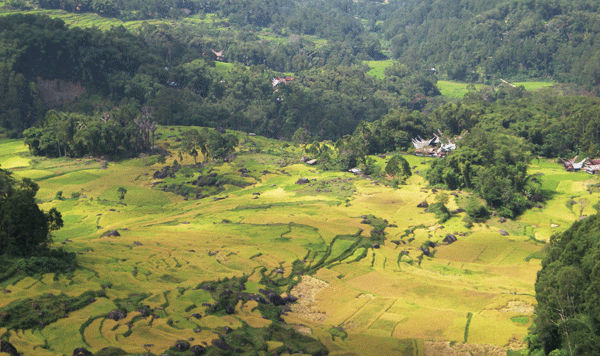By Hendra Gunawan and Endri Martini *
A few years ago, a mixed orchard based on coffee trees was hard to find in Konawe District in Southeast Sulawesi Province in Indonesia. The decline of coffee prices had forced farmers to plant other, more profitable commodities, such as cocoa, and government assistance programs focused on the development of cocoa with very little promotion of coffee.
Consequently, coffee was no longer a major source of income for farmers but only used to mark fence lines, particularly, Coffea liberica.
In 2012, the Agroforestry and Forestry in Sulawesi (AgFor) project—funded by the Department of Foreign Affairs, Trade and Development, Canada and the CGIAR Research Program on Forests, Trees and Agroforestry—started its activities in Konawe, one of which was to support coffee cultivation through a Farmers’ Field School (FFS).
The FFS included farming advice for five major commodities: coffee, cocoa, pepper, cloves and durian. Experts on the five were invited to give lectures, such as from the Research Institute for Spices and Medical Plant (Balittro) on pepper and cloves; the Indonesian Coffee and Cocoa Research Centre (Puslitkoka) for cocoa and coffee; and from the Tropical Fruit Research Center for durian.
One of the farmers who participated in the agroforestry FFS was deeply inspired to redevelop a coffee garden in Konawe. Mr Susi, 40, from Wonua Hoa Village in Hulu Lambuya Sub-district had been growing coffee since 1989, before cocoa was available, with only limited information he had gathered from his experience in working in Ladongi Sub-district, East Kolaka District, as a supervisor on a coffee and cocoa plantation.
His experience in Ladongi and the new knowledge offered by the coffee experts of Puslitkoka motivated him to reinvigorate his coffee garden.
Mr Susi planted coffee seeds of different varieties provided by AgFor both in an open area and also under shade trees (mixed with other plants). He found that the coffee under shade grew better and, hence, more broadly, that it was possible to grow profitable commodities under shade trees.
Such commodities can be managed without cutting other plants higher than them. Coffee could be grown on the margins of forests under the shade and also in cocoa garden and under the shade of Gliricida trees.
From the beginning, Mr Susi believed that coffee would sell well in the market, even if the price wasn’t as high as cocoa, because coffee was consumed daily by everyone in Konawe.
‘Everyone in this village drinks coffee. There is something missing if we don’t drink coffee’, said Mr Susi. ‘Right now, I am the only farmer in Wonua Hoa who grows coffee. I am very excited about the support from AgFor. Now I have a few types of good quality coffee in my garden. The Sigararutang coffee, for example, I sell to pay my debts’.
Even though not in large amounts, Mr Susi is now able to sell different commodities regularly. He claimed that, ‘there is always something ready to be harvested each month since I established the mixed-garden system. Harvesting alternately has made it possible for me to pay for my children’s education’.
Mr Susi is a good example for other villagers of an agroforester who makes higher, sustainable income without damaging the environment. He hopes that the local government can also provide support to farmers by creating policies that will profit all parties engaged in the marketing of coffee.
Market stability will motivate other farmers to grow coffee mixed with other plants, similar to Mr Susi.


















